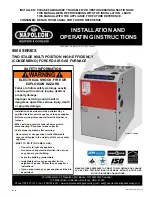
38
3. Place thermometers in the return and supply ducts as close
to the furnace as possible. Thermometers must not be
influenced by radiant heat from the heat exchanger.
Temperature Rise Measurement
Rise = Supply air temperature - Return air temperature
4. Subtract the return air temperature from the supply air
temperature to determine the air temperature rise. Allow
adequate time for thermometer readings to stabilize.
5. Adjust the temperature rise by adjusting the circulator blower
speed. Increase blower speed to reduce temperature rise.
Decrease blower speed to increase temperature rise. Refer to
“Circulator Blower Speeds” for speed changing details.
Circulator Blower Speeds
This furnace is equipped with a multispeed circulator blower. This
blower provides ease in adjusting blower speeds. The
Specification Sheet applicable to your model provides an airflow
table, showing the relationship between airflow (CFM) and
external static pressure (E.S.P.), for the proper selection of
heating and cooling speeds. The cooling blower speed is set at
High and the heating blower speed is set as indicated in the
Specification Sheet applicable to your model. These blower
speeds should be adjusted by the installer to match the
installation requirements so as to provide the correct heating
temperature rise and correct cooling CFM.
To adjust the circulator blower speed, proceed as follows:
1. Turn off the power to the furnace.
2. Select the heating and cooling blower speeds that match the
installation requirements from the airflow table in the
Specification Sheet.
3. Relocate the desired motor leads to the circulator blower heat
and cool speed terminals on the integrated control module.
(Terminals are identified as LO HEAT-H, HI HEAT-H and
COOL-H (hot). If a heating speed and the cooling blower
speed are the same, a jumper wire must be used between the
heat and cool terminals.
4. Connect all of the unused blower motor leads to the “PARK”
terminals on the integrated control module. Any leads not
connected to the “PARK” terminals must be taped.
5. Turn on the power to furnace.
6. Verify the proper temperature rise as outlined in “Temperature
Rise.”
NORMAL SEQUENCE OF
OPERATION
Power Up
The normal power up sequence is as follows:
■
115 VAC power applied to furnace.
■
Integrated control module performs internal checks.
■
Integrated control module LED will light.
■
Integrated control module monitors safety circuits
continuously.
■
Furnace awaits call from thermostat.
Heating Mode—Mode DIP Switch Set to
1 STG Position
The normal operational sequence in heating mode is as follows:
■
R and W thermostat contacts close, initiating a call for heat.
■
Integrated control module performs safety circuit checks.
■
Induced draft blower is energized for a 15-second prepurge
period causing the pressure switch contacts to close.
■
Igniter warm-up begins after 15-second prepurge expires.
■
Low-stage and high-stage gas control valves open at the end
of the igniter warm-up period, delivering gas to the burners
and establishing flame.
■
Integrated control module monitors flame presence. Gas
control valve will remain open only if flame is detected.
■
Circulator blower is energized on high heat speed following a
fixed 30-second blower on delay. Electronic air cleaner
terminals are energized with circulator blower.
A. Heat exchanger radiation
“line of sight”
B. Supply air
C. Supply air temperature
D. Return air temperature
E. Return air
A
B
C
D
E
Goodman 80
To prevent premature failure of heat exchanger, property
damage, personal injury or death, do not adjust the limit
control (factory set).
WARNING
WFD19, WGFM19 Circulator Blower Speeds
Low
Red
Medium Low
Orange
Medium High
Blue
High
Black
Common/Neutral
White
WFM19 Circulator Blower Speeds
T1-Low
Yellow
T2-Med-Low
Red
T3-Med
Orange
T4-Med-High
Blue
T5-High
Black
Common/Neutral
White















































